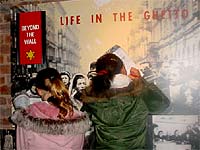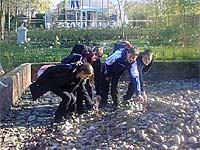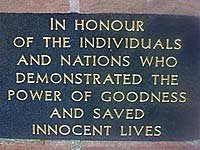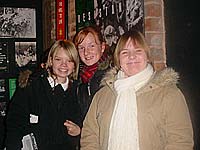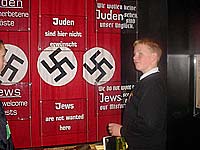
Home Page Project ListingsProject OverviewBackground / ContextLearning ResourcesUseful Links |
Their Past, Your FutureBy Newcastle Community High School. Those involvedIt was decided to deliver the topic through History to the whole of Year 9 ( some 140 students) using History lessons where the Holocaust itself would be studied. In addition to this, 30 pupils were given the opportunity to produce art work for display at the New Vic Theatre in Newcastle. As part of the course, places were made available to 55 pupils to visit the Beth Shalom Holocaust Memorial Centre to meet a Holocaust survivor and listen to their story. This was designed to make the topic more real for the students. Aims and objectives
Most importantly, to educate pupils about what happened in Europe in the 1930s and 1940s but also to highlight that this has happened before and continues to happen. The key point here is to help them to understand what they can do to stop it happening again.
ActivitiesThe first activity centred around the production of an essay for a History unit for Year 9 pupils entitled: “How terrible was the Holocaust? A study of different historical interpretations.” Firstly, students were given information concerning the situation in Germany in the 1920s and 1930s, so that pupils could understand the reasons why someone like Hitler could gain power. This also involved a breakdown of Hitler’s ideas but also ideas connected to democracy and Communism around at the time. In addition to this, they were made aware of key words such as “racism“, “holocaust” and “genocide”. It was at this point that information was given to students on the holocausts in Bosnia, Kosovo and Rwanda. The students then looked into the stages that Hitler went through in dealing with the Jews:
Once this background information was dealt with we began to look at the 3 different interpretations of the Holocaust:
The visit to the Holocaust Museum was specifically designed to occur after the students had been shown “ Schindler’s List”. At the same time, students are reminded of their study of Anne Frank in R.E in Year 8. The students are picked on a “first come, first served” basis, which allows us to gather a fair cross-section of the Year group to take on the trip.
Whilst there, the students see a video produced by the Museum on how the Holocaust affected Jews of all ages across Europe. They also have an opportunity to visit the Memorial garden. They then get to meet the Holocaust survivor. This sis the part that the students remember most vividly. They gain so much information from this. They are often in awe of this person and what they have been through. They also love the opportunity to ask this person questions. It is this “hands-on History” aspect that the students love the most. By the time they get back to School they can’t wait to get their hands on the new interpretations. They are particularly angered by the views of David Irving. This has had added weight recently with the news of his arrest and subsequent imprisonment by the Austrian authorities for his denial of the Holocaust. The final activity centres around the Holocaust Memorial Day celebration organised by Staffordshire County Council. This year, Year 9 pupils provided the majority of the art work for the exhibition. In the past we have choreographed and performed Dance for the performance itself.
OutcomesMany pupils have become more confident and opinionated in lessons. This study has made them more aware of their rights but also how important it is to protect and value those right. It has increased interest in the subject of History at GCSE. It has also led to a cross-over into RE and increased interest in Citizenship. Pupils now have a better understanding of why the study of Citizenship is important to them. Pupils have a better understanding of how life can change. Mostly, they have an increased understanding of the power that politicians have over us and how important it is to check their powers. Pupils have developed source analysis skills very quickly. There has also been an increased interest from a Careers point of view. Many have used the interpretational side of the question to look into jobs such as journalism, law and the police as well as looking into further study of the subject of History itself. Their essay writing skills have improved, especially at the planning stage. They are also better at organising their verbal arguments, but in a controlled way. Many have realised that controlled and organised debate goes much further than confrontational argument and accusation.
It has also led to a much greater understanding and empathy with the older generation. This was evident on the day, in the way that the students treated the lady concerned - with total respect and amazement. It shocked the students that someone so small, and from the photos that she brought, so young, could have survived such a terrible thing. The students at our school are not particularly well off but so many bought books from the Museum shop so she could sign them, that they ran out. It has also come back with them, however. Many of them have become involved in a Citizenship project back at School aimed at providing Tea and entertainment for the elderly. There has also been a marked fall in the number of complaints from local estates about the attitude of pupils to the elderly in the area. Many pupils now openly talk to the older generation that live near them. There has also been a marked increase in the number of students talking about the exploits of their older relatives during the war. Overall, this project has motivated many students right across the ability range. Many students in other Year groups have also started asking about when they are going to do it This has encouraged us as a Department to continue with this in the future but it has also had wider-ranging benefits for the School and the local community. |
